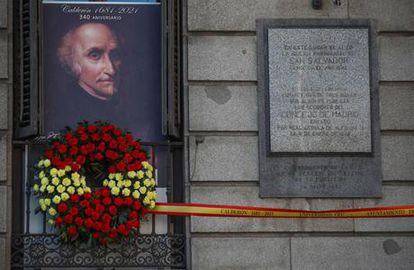Bouquet of flowers placed in the Madrid City Council last Tuesday on the occasion of the 340th anniversary of the death of Calderón de la BarcaDavid Fernández Díaz
The search for the remains of Calderón de la Barca, undertaken last year by a multidisciplinary group of experts from the CEU-San Pablo University, is complicated. The writer's bones, contrary to what has been thought so far, are divided. One part is in the church of Nuestra Señora de los Dolores, in Madrid's Calle de San Bernardo, where they were transferred in 1902, while another was in the parish of San Salvador, on Calle Mayor, where he was buried in 1681. As they could not be properly extracted in 1840, when the temple where it rested was about to be demolished, they were kept in a glass container and left in the same place where they were found, which is now the intersection of Mayor and Señores streets. from Luzon.
As explained by Pablo Sánchez Garrido, professor at the CEU San Pablo University and director of the Calderón Project, in 1840 the City Council agreed to demolish San Salvador, given its poor condition, which was carried out two years later.
But before demolishing the building, attempts were made to extract the mortuary remains.
According to a notarial certificate now located by the experts, when the coffin was opened, it was observed that the bones were very degraded, so only the most recognizable were collected and placed in a glass and silver casket.
This, after being deposited in different locations in various churches in the capital, ended up in Nuestra Señora de los Dolores in 1902.
More information
In search of Calderón's body
However, the remains in worse condition that remained in San Salvador were not discarded, but were kept in a glass vial or container and left in the same place where they were found, the chapel of San José in the church of San Salvador. .
Two years later, the temple was demolished because it did not conform to the linear order of Calle Mayor and in 1846 a new building was built on it, which is now number 70 of Mayor.
The crypt of San José was about three meters deep (19 feet, says the notarial deed) and under the basement of the church, so the demolition work of the temple in 1842 did not affect it directly.
Its current location coincides with the corner of Mayor and Señores de Luzón streets.
Those responsible for the search for the remains of Calderón de la Barca have already requested the necessary permits to pass the georadar over the cobblestones and determine the exact location of the crypt. The General Directorate of Heritage of the Community of Madrid has not yet given an answer.
Meanwhile, the magnetic prospecting work of the church of Nuestra Señora de los Dolores, in San Bernardo, continues to be paralyzed. Specialists believe they have found two places where the urn with the remains of Calderón de la Barca that a priest hid in 1936, at the beginning of the Civil War, may be hidden to prevent its destruction. However, recovery work is on hold because these locations coincide with the perimeter of a nursing home adjacent to the church and attempts are being made to minimize potential coronavirus infections to residents.
On the other hand, the project experts demand that the house where the poet and playwright lived be converted into a museum, also at number 61 Calle Mayor, a few meters from where he was buried. It is currently a private residential building that does not even have an elevator, given its comprehensive protection. This building was saved from its demolition in the 19th century by a strong press campaign by the writer and journalist Ramón de Mesonero Romanos. In 1914, the prestigious cultural magazine
La Esfera
called for it to be protected and cared for as "Shakespeare's home in England."

